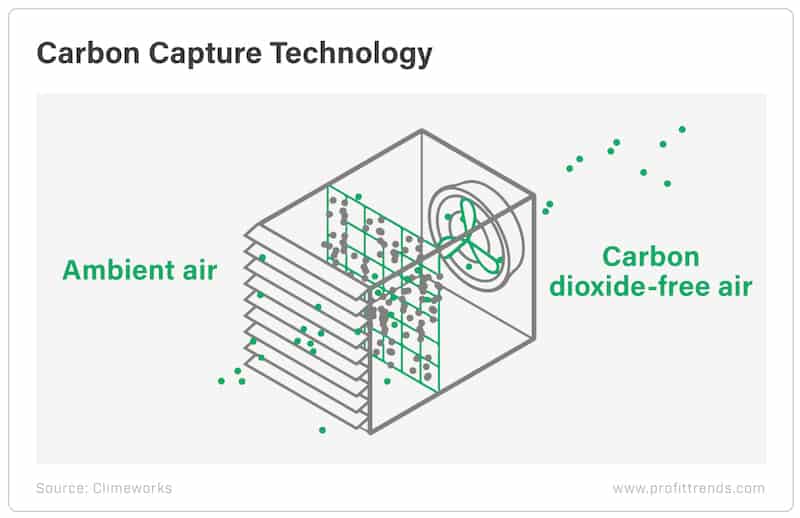As a society, we’ve spent the past 100 years or so spewing carbon dioxide into the atmosphere. We had no idea this would eventually lead to climate change.
Now we’re stuck with the challenge of reversing the process and removing carbon dioxide from the atmosphere.
As I write this, there are a number of technologies emerging to remove and sequester carbon dioxide from the air. And they are going to present some fantastic investment opportunities.
Let’s take a look at one of the most promising ones.
How It Works
Direct carbon capture is one of the main routes to remove carbon dioxide from our atmosphere.
During this process, a fan draws air through vents. The carbon-laden air passes through a special filter that captures the carbon dioxide on the filter’s surface.
[Wall Street Insider: Why Dec. 31 Announcement is Big News for American Investors]
Once the filter can hold no more carbon dioxide, the collector cabinet is closed and the temperature is increased to between 80 and 100 degrees Celsius.
This releases carbon dioxide from the filter medium. This pure carbon dioxide can then be concentrated, stored for transport and sale, or sequestered.
Several studies have shown that we’ll have 50,000 carbon-capture plants by 2050. And for good reason: They’ll need to remove 10 billion tons of carbon dioxide from the air annually.
But in order for this to happen, we will need to globally invest about $10 trillion into this technology.
Clearly, direct carbon capture will have to be massively scaled up.
Carbon Capture Pilot Programs
Two large carbon capture pilot projects are already underway in Norway and Iceland.
Norway has been Europe’s biggest oil and gas producer for decades. As a result, it has amassed the world’s largest sovereign wealth fund of nearly $1.3 trillion. And the country is funding 80% of the carbon capture Longship project – to the tune of $2.6 billion.
The overall project involves collecting carbon dioxide from one of Norway’s large cement factories. It’s also collecting carbon from a big waste-to-energy plant.
[Trend Alert: Three of the World’s Richest Billionaires Are Quietly Piling Into THIS]
The carbon dioxide is collected, compressed, liquified and stored in insulated tanks. It is then transferred to a special ship that transports the liquid carbon dioxide to a large-capacity onshore plant. This plant pumps the liquid carbon dioxide through a pipeline to an offshore injection well.
The carbon dioxide is permanently transferred to undersea reservoirs located 1,000 to 2,000 meters below the seabed.
Equinor ASA (NYSE: EQNR), Royal Dutch Shell (NYSE: RDS-A) and TotalEnergies SE (NYSE: TTE) are funding the remaining 20% of the cost of this project. They all have decades of expertise in drilling into the seabed and handling gases.
Next, Iceland is home to another big carbon dioxide removal project. For this project, the Icelandic company Carbfix mixes water with carbon dioxide. It then pumps the mixture deep underground into a basaltic rock formation. After a few years, a process known as natural mineralization occurs.
This causes the carbon dioxide to react with the basalt and turn into stone.
This way, the carbon dioxide is out of the air and back in the earth. Permanently.
Unfortunately for investors, none of these pioneering companies are publicly traded right now. But I’m sure that won’t be the case for much longer.
Remember, we’re talking about the massive scale-up of carbon capture in order to effectively address climate change. You can bet that I’ll be following developments as this exciting field grows.
And we’ll look to capture profits when the opportunity presents itself.
Good investing,
Dave
[Exclusive: 3 Clean Energy Stocks Set to Soar Under President Biden]

